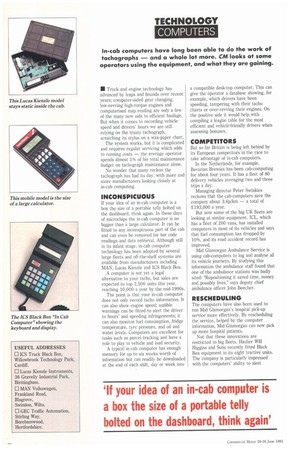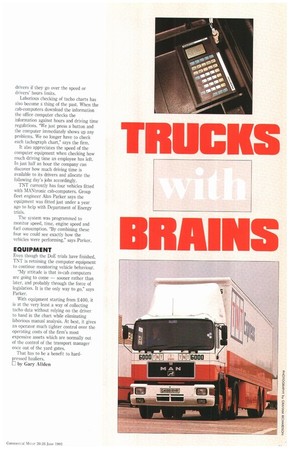• Truck and engine technology has advanced by leaps and
Page 40

Page 41

If you've noticed an error in this article please click here to report it so we can fix it.
bounds over recent years; computer-aided gear changing, low-revving high-torque engines and computerised map reading are only a few of the many new aids to efficient haulage. But when it comes to recording vehicle speed and drivers' hours we are still relying on the trusty tachograph, scratching its stylus on a wax-paper chart.
The system works, but it is complicated and requires regular servicing which adds to running costs — the average operator spends almost 1% of his total maintenance budget on tachograph maintenance alone.
No wonder that many reckon the tachograph has had its day, with more and more manufacturers looking closely at in-cab computing.
INCONSPICUOUS
If your idea of an in-cab computer is a box the size of a portable telly bolted on the dashboard, think again. In these days of microchips the in-cab computer is no bigger than a large calculator. It can be fitted to any inconspicuous part of the cab and can even be removed for bar code readings and data retrieval. Although still in its infant stage, in-cab computer technology has been adopted by several large fleets and off-the-shelf systems are available from manufacturers including MAN, Lucas Kienzle and ICS Black Box.
A computer is not yet a legal alternative to your tacho, but sales are expected to top 2,500 units this year, reaching 10,000 a year by the mid-1990s.
The point is that your in-cab computer does not only record tacho information. It can also show engine speed; audible warnings can be fitted to alert the driver to hours' and speeding infringements; it can also monitor fuel consumption, fridge temperature, tyre pressure, and oil and water levels. Computers are excellent for tasks such as parcel tracking and have a role to play in vehicle and load security.
A typical in-cab computer has enough memory for up to six weeks worth of information but can readily be downloaded at the end of each shift, day or week into a compatible desk-top computer. This can give the operator a database showing, for example, which drivers have been speeding, tampering with their tacho charts or over-revving their engines. On the positive side it would help with compiling a league table for the most efficient and vehicle-friendly drivers when assessing bonuses.
COMPETITORS
But so far Britain is being left behind by its European competitors in the race to take advantage of in-cab computers.
In the Netherlands, for example, Bavarian Brewies has been cab-computing for about four years. It has a fleet of 80 delivery vehicles averaging two and three trips a day.
Managing director Peter Swinkles reckons that the cab-computers save the company about 3.6p/km — a total of £193,000 a year.
But now some of the big UK fleets are looking at similar equipment. ICL, which has a fleet of 200 vans, has installed computers in most of its vehicles and says that fuel consumption has dropped by 10%, and its road accident record has improved.
Mid Glamorgan Ambulance Service is using cab-computers to log and analyse all its vehicle journeys. By studying this information the ambulance staff found that one of the ambulance stations was badly sited: "Repositioning it saved time, money and possibly lives," says deputy chief ambulance officer John Beecher.
RESCHEDULING The computers have also been used to run Mid Glamorgan's hospital pick-up service more effectively. By rescheduling the service, helped by the computer information, Mid Glamorgan can now pick up more hospital patients.
Not that these innovations are restricted to big fleets. Haulier WH Higgins and Sons recently fitted Black Box equipment in its eight tractive units. The company is particularly impressed with the computers' ability to alert drivers if they go over the speed or drivers' hours limits.
Laborious checking of tacho charts has also become a thing of the past. When the cab-computers download the information the office computer checks the information against hours and driving time regulations. "We just press a button and the computer immediately shows up any problems. We no longer have to check each tachograph chart," says the firm.
It also appreciates the speed of the computer equipment when checking how much driving time an employee has left. In just half an hour the company can discover how much driving time is available to its drivers and allocate the following day's jobs accordingly.
TNT currently has four vehicles fitted with MANtronic cab-computers. Group fleet engineer Alan Parker says the equipment was fitted just under a year ago to help with Department of Energy trials.
The system was programmed to monitor speed, time, engine speed and fuel consumption. "By combining these four we could see exactly how the vehicles were performing," says Parker.
EQUIPMENT
Even though the DoE trials have finished, TNT is retaining the computer equipment to continue monitoring vehicle behaviour.
"My attitude is that in-cab computers are going to come — sooner rather than later, and probably through the force of legislation. It is the only way to go," says Parker.
With equipment starting from £400, it is at the very least a way of collecting tacho data without relying on the driver to hand in the chart while eliminating laborious manual analysis. At best, it gives an operator much tighter control over the operating costs of the firm's most expensive assets which are normally out of the control of the transport manager once out of the yard gates.
That has to be a benefit to hardpressed hauliers.
O by Gary Allden
























































































